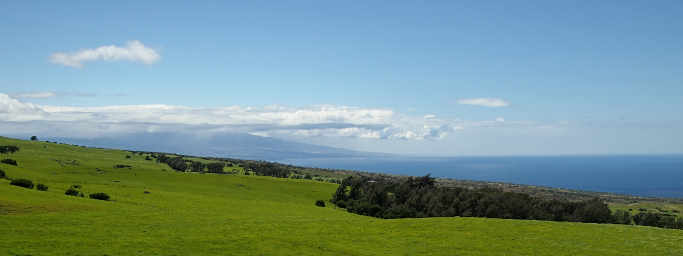
When we left Pololu, we were headed for Waipio. It's a similar sort of valley about twelve miles to the southeast. There are five or six of these steep valleys that drop down to the coast from the Kohala mountains. There is a trail from one end to the other on our map, but it is a multi-day trip and we didn't have time (or our big backpacks) to do that, unfortunately. There's no road through them (a good thing). It's beautiful country, but all we could do was go around it. To get from Pololu to Waipio by car, you back up to Hawi and take the highway that goes half way up the west side of the Kohala mountains, go around them, and then go back north to another end of the road.
The Kohala ranching country is fascinating. When you think of big ranches, most people think of the American west. But there were big ranches on the island of Hawaii long before much of the American west was settled. The week before when we were at the beach in Kialua on Oahu with Dona's sister Mary and her daughter Tara and her two kids, a young girl about Shaun's age looked like she wanted to help us make sand castles. So we got her involved, and after a while I started talking with her father. He was recovering from a horse accident, and had a rather swollen foot where it had been injured. It turned out he worked on a local ranch, so we got to talking about ranching and Hawaii, and he told me one of the oldest ranches in the country, the Parker Ranch, is located on the big island. The manager of the ranch he worked for had spent a lot of time working on the Parker Ranch. I'd read a little about it, but it was fun to meet someone actually connected to it. The story of how the ranch came to be is a classic movie script -- a few cows dropped off by Captain Vancouver on one of his early voyages, a sailor who jumpped ship and eventually married a Hawaiian chief's daughter... In any case, this was ranching country, and some of the first cowboys in what is now the United States were gathering wild cows and calves in the thickets of the volcanic mountains of northern Hawaii.
The western slopes of the mountains are open country, well watered up high, and grass grows well year around. So they can graze year round, something which has to give them a huge market advantage. It's a crazy landscape looking from the well-watered highlands down towards the ocean, where the moisture runs out and lava and desert predominate.
 |
| Typical Kohala Ranchland |
 |
| Well-watered Grassland to Lava Desert transition |
It's windy country, as the trees remind you. The winds build up over the ocean for thousands of miles, and the islands as but a small blip in their race across the globe.
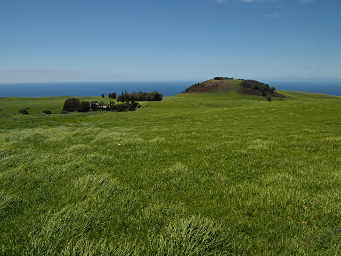 |
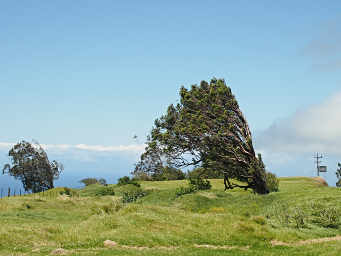 |
| Typical Kohala Pastureland | Does the wind blow, or what? |
The highway was high enough that we got above the clouds, and could see the summit of Mauna Kea. The town of Wiamea is located at the south end of the Kohala mountains, midway between the wet east and the dry west. As we dropped down to Wiamea, you could see the dividing line between east and west. In the space of less than a block, you could see the transition from green, wet eastern climate to dry western climate.
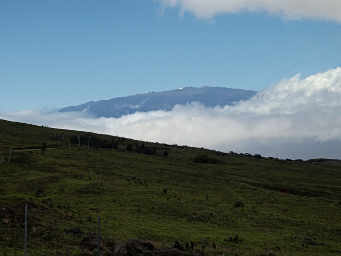 |
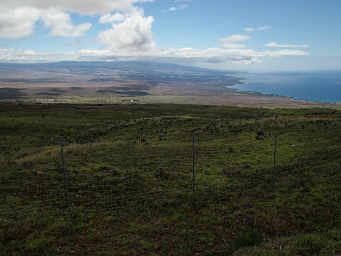 |
| Mauna Kea Summit | Dry Kohala West Coast |
We reached the east coast and drove back north to Waipio, at the end of the road. You can take a four-wheel drive vehicle down to the valley floor, ford the stream, and drive to the north end of the beach, where a trail starts. The trail goes up and over the next major ridge, then down to the beach in the next valley at Waimanu Bay. It strikes me as a great adventure, although I'm not sure Dona would go for it. In any case, we didn't have our big backpacks, and we didn't have the time. Damn. Life is waaaaay too short! We still had to get to our campsite for the night, so we headed back south, to Laupahoehoe.
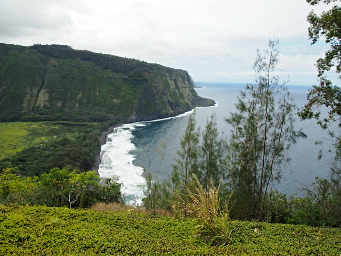 |
| Waipio |